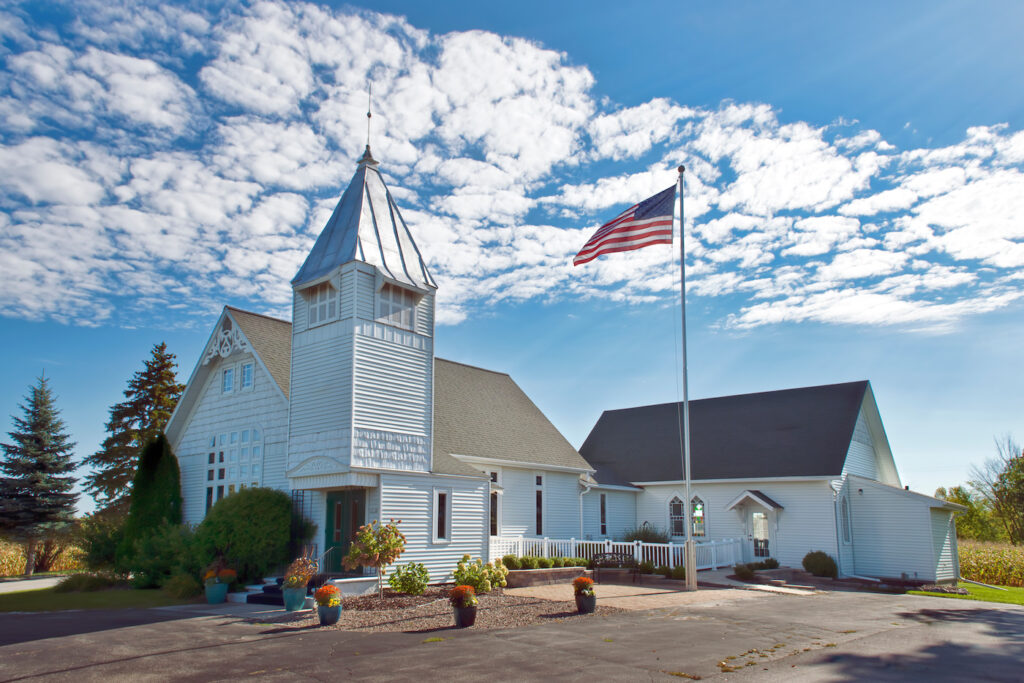From 2016 onward, the relationship between conservative Christianity and MAGA-style populism has generated a wide range of reactions, few of them dispassionate. Center-right evangelicals lament the populist strand of the religious right and distinguish it from the moral strand. Critics on the left argue that the populist and moral strands were always one and the same. They declare MAGA politics to be the culmination of a radicalized religious right, and issue blanket condemnations. Postliberal Christian thinkers see a religious populist backlash as the natural consequence of the excesses of American liberalism. They exult in the prospective crumbling of the liberal system, hope for a robust Christian social order to replace it, and issue calls to arms.
These perspectives contain varying degrees of insight, but none is quite satisfactory as an explanation of how we got here. In his new book The Godless Crusade: Religion, Populism, and Right-Wing Identity Politics in the West (Cambridge University Press 2023), Tobias Cremer offers a different interpretation of the conspicuous religious element in modern populist politics. He argues that across Western democracies, populist parties are increasingly employing religious symbolism and rhetoric in an identitarian rather than a religious way. What appears to be an embrace of Christianity is more a celebration of cultural markers (say, Christian history and architecture) used to define themselves against outsiders than an expression of Christian beliefs or moral commitments—Christendom without Christianity. Mobilizing statistics, political analysis, and the content of interviews with 114 political and religious leaders in Germany, France, and the United States, Cremer makes a strong case that religious-themed populism is not the result of religious revival or even backlash, but rather of secularization. This work marks a key contribution to conversations about religious populism and Christian nationalism.
What appears to be an embrace of Christianity is more a celebration of cultural markers used to define themselves against outsiders than an expression of Christian beliefs or moral commitments—Christendom without Christianity.
Secular Uses of the Sacred
Start your day with Public Discourse
Sign up and get our daily essays sent straight to your inbox.Cremer’s argument is fourfold. First, the old economic and moral cleavages that used to shape party politics in Western democracies are being supplanted by a new division between cosmopolitans and communitarians. Cosmopolitans embrace globalization, individualism, and multiculturalism, whereas communitarians place greater value on local attachments, inherited identities, and majority rights. The latter group, finding themselves culturally maligned by internal elites and demographically threatened by external immigrants, seek redress in the form of a combative, “us vs. them” populist style of politics. Second, right-wing populists wield Christian symbolism as a way of marking cultural identity rather than religious belief. For populist leaders seeking to forge a shared national identity in a diverse population, Christianity serves as a symbolically powerful “lowest common denominator” as well as a boundary marker against Muslim immigrants. Third, and crucially, populist use of religious symbolism resonates most strongly with nonreligious voters, while practicing Christians are comparatively immune. Fourth, this “religious immunity” to right-wing populism is dependent on the availability of appealing political alternatives for religious voters, as well as the extent to which religious leaders discourage support for populist parties among their followers.
Cremer illustrates these points with an in-depth examination of the cases of Germany, France, and the United States, each of which receives its own section of the book. All three of these countries saw a rise in the demand for populist politics during the 2010s— Alternative für Deutschland (AfD) in Germany, Marine Le Pen’s Rassemblement National (RN) in France, and Trump’s Republican Party in the United States. In each of these cases, populist use of religious symbols has been highly visible. AfD supporters march in Dresden singing hymns and wielding large crosses. French demonstrators by the thousands, organized by RN, deposit flowers at the feet of a statue of the country’s national saint, Joan of Arc, in veneration. In the United States, crowds wielding bibles and waving Christian flags storm the Capitol building in defiance of the outcome of the 2020 election. Observers of these spectacles draw the seemingly reasonable conclusion that they represent a radicalized religious right in the democratic West.
For populist leaders, Christianity serves as a symbolically powerful “lowest common denominator” as well as a boundary marker against Muslim immigrants.
But this conclusion, Cremer argues, is mistaken. In each of these countries, populist use of religious symbolism has coincided with the marginalization of Christian belief and practice within populist parties. In Germany, AfD expresses skepticism toward the nation’s system of state-supported churches and resists the high social and political status of religious leaders, preferring a reduced role for religion in the public square. France’s RN similarly embraces an extreme form of public secularism, or laïcité. Neither AfD nor RN shows any interest in a conservative social agenda on such issues as same-sex marriage or abortion. Indeed, many statements by populist party leaders explicitly identify the kind of Christianity they advocate as cultural or identitarian rather than religious, and reject the prospect of their parties being influenced by Christian doctrine. While the United States differs in some key respects, the Trump administration shared with its European counterparts an elevation of nonreligious or populist figures over religious ones. Most religious leaders had little access to the Trump White House, and while he maintained an evangelical Faith Advisory Board, Cremer’s interviewees suggest this represented a strategic effort to curb religious criticism rather than any serious desire to institute a Christian policy agenda. In Trump’s administration, the Steve Bannon wing loomed larger than the Mike Pence wing (and current tensions between the Trump campaign and the pro-life movement suggest that not much has changed). Similarly, in AfD and RN Christian members are marginalized while secular, atheist, or neo-pagan strands of the parties wield greater influence.
Religious Immunity
Interviews with religious leaders show that the relationship between religion and right-wing populism is chilly on both sides. In Germany, Catholic and Protestant leaders have been consistent and outspoken critics of AfD, instituting strong social taboos against populist support among their members. Until recently, the French Catholic Church similarly denounced RN without equivocation, even denying sacraments to some of the party’s politicians. Cremer credits strong social taboos against participation in populist politics instituted by religious leaders for the fact that churchgoing Catholics and Protestants in these countries have historically exhibited low support for these parties, indicating a “religious immunity” effect.
Early in the 2016 primaries, this effect was in evidence in the United States as well. Several prominent religious leaders declared Trump an unfit candidate for office, and in the primary vote, churchgoing Republicans were substantially less likely to support Trump than their religiously disengaged co-partisans. Yet by the time of the general election, religious voters were some of his most loyal supporters. Cremer identifies several factors that explain this reversal. First, party loyalty—religious support for the GOP was too entrenched to be disrupted by the nomination of a decidedly irreligious candidate. Second, a lack of alternatives—in a two-party system, the only other serious contender was a Democratic Party with a secularist stance and socially liberal policy platform wholly unacceptable to many religious voters. Third, the Trump campaign made inroads with evangelical leaders and made policy commitments that were appealing to the religious right. Fourth, given the diffuse and non-hierarchical nature of America’s churches, there was a lack of religious leaders with sufficient ability and influence to oppose the right-wing populist movement as clergy in France and Germany had done. These factors in combination undermined the “religious immunity” effect in the United States.
Ultimately, Cremer is positing a Europeanization of American politics in which social cleavages have less to do with economics or morality than the value of national and cultural identity. This shift is captured in a quote from sociologist Eric Kaufmann: “During the Bush years European observers saw American politics as profoundly alien. By 2016 it was to become thoroughly familiar.” American analysts have struggled to provide an accurate diagnosis because they are thinking in categories of class struggles and culture wars that are becoming outdated. For insight into our political moment, we should look across the pond.
Post-religious Right
With respect to the question of “how we got here” in the American case, Cremer’s key insight is that Trump—and more broadly, the style of politics he represents—did not rise to power on the shoulders of the religious right, but rather the post-religious right. Indeed, his presidency was made possible by the very process of secularization that the religious right has long sought to combat. Trump’s coalition may instead be viewed as an alliance between the religious and post-religious right, with the former playing the role of junior partner. Counterintuitively, the conspicuous Christian symbolism present in such populist settings as MAGA rallies and the January 6 storming of the Capitol does not reflect a resurgent and radicalized religious right, but rather one that has been eclipsed by more secular right-wing forces. This understanding offers an important corrective to reductionistic accounts of a Christian nationalist monolith that have dominated scholarship in this area.
Counterintuitively, the conspicuous Christian symbolism present in such populist settings as MAGA rallies and the January 6 storming of the Capitol does not reflect a resurgent and radicalized religious right, but rather one that has been eclipsed by more secular right-wing forces.
While Cremer’s theory goes a long way toward helping us make sense of the past decade’s bewildering political developments, however, it pays little heed to evidence of at least partial overlap between the religious and populist right. Religion data scientist Ryan Burge has shown that in the 2016 Republican primaries, 44 percent of weekly-or-more churchgoers voted for Trump over evangelical candidates like Ted Cruz. This is, if not an outright endorsement, hardly a stinging rebuke. Figures with unimpeachable religious right credentials such as Eric Metaxas have come out as full-throated Trump supporters, while center-right evangelicals like David French and Tim Alberta lament the MAGA-fication of their religious communities. Clearly for many Americans, the tension between their religious commitments and populist politics is surmountable.
On the other side of the ledger, the religious right gained undeniable policy victories from their alliance with the populist right. The religious conservative Holy Grail of the overturning of Roe v. Wade would not have happened if religious voters had withheld support for Trump in the 2016 general election. These facts suggest a possibility absent in France or Germany, where weekly worship attendance is in single digits, but perhaps present in the United States: that of a populist religious right. The populist political style is not incompatible with either religious commitment or social conservatism, and social boundaries can be drawn around religion and morality as easily as birthplace or ethnicity. GOP lawmakers in red states like Texas and Montana offer a taste of what a populist politics that emphasizes religion over ethnicity might look like. Cremer rightly draws our focus to the distinctions and tensions between the religious and populist right, but we should also not lose sight of the prospect of their synthesis.
This caveat aside, The Godless Crusade offers an elegant, compelling, and well-researched account of the overlooked role of secularized religious-themed populism on both sides of the Atlantic—one refreshingly free of pontificating. It deserves to be widely read. Cremer both builds on and challenges existing accounts. His book can create more fruitful conversations about conflicts over the role of religion in the public sphere.














